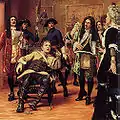Nils Forsberg
Nils Forsberg (17 December 1842 – 8 November 1934) was a Swedish painter who lived and worked in Paris for much of his career.[2]
Nils Forsberg | |
|---|---|
 | |
| Born | Nils Forsberg 17 December 1842[1] |
| Died | 8 November 1934 (aged 91)[1] |
| Nationality | Swedish |
| Known for | Painter |
Life
Forsberg was born in a small village called Riseberga, in the province of Scania.[3][1] The son of a peasant, he spent his early years in farming, then was apprenticed to a house-painter at Göteborg.[3] He made a statue of Minerva which procured for him a government stipend which enabled him to go to Paris in 1867.[3] In Paris he was a student in the atelier of Léon Bonnat.[4][3][5] Art historian Richard Muther would later write that Forsberg "became the Swedish Bonnat".[6] The siege of Paris, during which he enlisted in the Ambulance Department, afforded him opportunities for studying and sketching the scenes that he observed.[3] In 1877 he exhibited Family of Acrobats before the Circus Director, now in the Gothenburg Museum of Art.[3] This work, which typifies Forsberg's commitment to social reform, shows the influence of the French Realists in its depiction of child labor.[2]
_-_Nationalmuseum_-_18422.tif.jpg.webp)
In 1888 he received the gold medal at the Salon for his painting The Death of a Hero,[5][6][7] now in the Nationalmuseum of Stockholm.[8] The culmination of his ambition to renew traditional history painting with a vigorous contemporary realism, it took him several years to complete, and was inspired by his experiences during the Franco-Prussian War.[2] Afterwards he devoted himself more especially to historical subjects.[3] In 1904 he returned to Sweden, where he lived in Helsingborg.[2] He died in Helsingborg on 8 November 1934.[1][2]
He had a son, Nils Forsberg the younger (b 1870), who was also a painter.[2]
Permanent collections
In total, 25 of Forsberg's works are held by the Nationalmuseum.[8] Several of his works, including the 1900 painting Gustaf II Adolf before Battle of Lützen,[9] are held by the Gothenburg Museum of Art.[10]
Gallery
_-_Nationalmuseum_-_20117.tif.jpg.webp) A Communard (1871) Nationalmuseum
A Communard (1871) Nationalmuseum_-_Gothenburg_Museum_of_Art_-_GKM_0178.tif.jpg.webp) Family of Acrobats before the Circus Director (1877)
Family of Acrobats before the Circus Director (1877) Gustav II Adolf before the Battle of Lutzen of 1632, in which the king died. Gothenburg Museum of Art, 1900
Gustav II Adolf before the Battle of Lutzen of 1632, in which the king died. Gothenburg Museum of Art, 1900 Stenbock's Courier (1911)
Stenbock's Courier (1911)_-_Nationalmuseum_-_19767.tif.jpg.webp) Self-portrait (1882)
Self-portrait (1882)
References
- Oscar Harald Wieselgren (1944). Svenska män och kvinnor: biografisk uppslagsbok. Bonnier. p. 555.
- Gunnarsson, T. (2003). "Forsberg, Nils, the elder". Grove Art Online.
- "Forsberg, Nils". In Gilman, Daniel Coit; Peck, Harry Thurston; Colby, Frank Moore (1907). The New International Encyclopædia. Vol. 8. Dodd, Mead, and Company. p. 58.
 This article incorporates text from this source, which is in the public domain.
This article incorporates text from this source, which is in the public domain.
- Fae Brauer (8 July 2014). Rivals and Conspirators: The Paris Salons and the Modern Art Centre. Cambridge Scholars Publishing. p. 92. ISBN 978-1-4438-6370-4.
- "Nils Forsberg". Benezit Dictionary of Artists (2006). ISBN 9780199773787.
- Richard Muther (1896). The History of Modern Painting. Henry and Company. p. 355.
- "Fine Arts in 1888". In Appletons' Annual Cyclopedia and Register of Important Events. D. Appleton & Co. 1889. p. 332.
- "Nils Forsberg". Nationalmuseum.
- Jonas Jonson (2016). Nathan Soderblom: Called to Serve. Wm. B. Eerdmans Publishing. p. 76. ISBN 978-0-8028-7308-8.
- "Nils Forsberg". Gothenburg Museum of Art. Archived from the original on 2018-06-03. Retrieved 2020-12-06.
Further reading
- "Forsberg, Nils". Vem är det (1944). (in Swedish)
- "Forsberg, 2. Nils". Nordisk familjebok (1908). (in Swedish)
- "Nils Forsberg". Svenskt biografiskt lexikon (1964-1966). (in Swedish)